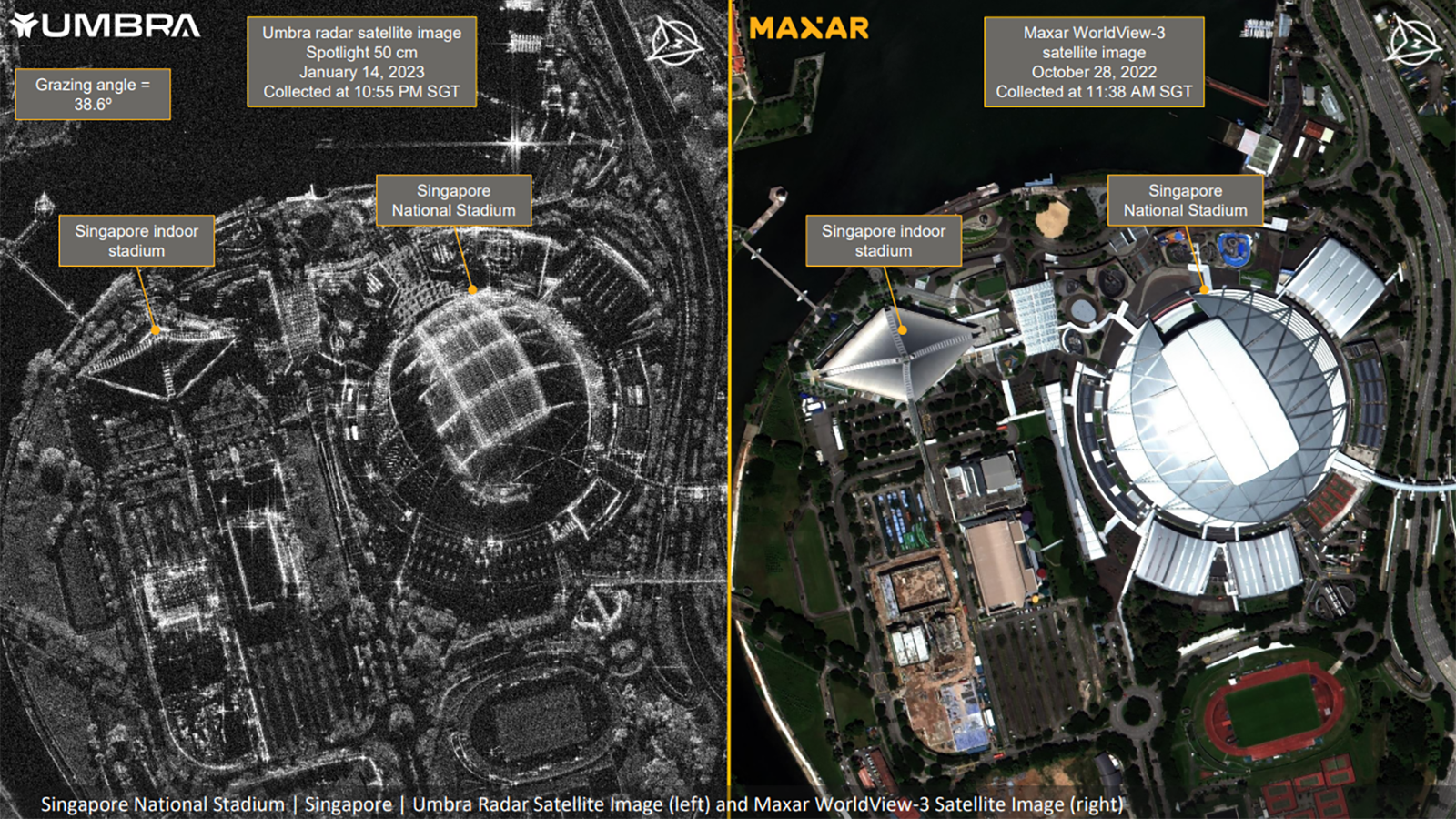
Comparison of satellite imagery from Umbra (right) and Maxar (left). (Maxar)
WASHINGTON — Remote sensing giant Maxar Technologies has inked an agreement with startup Umbra for dedicated access to the latter’s synthetic aperture radar (SAR) imagery constellation, the companies announced today.
“Maxar and Umbra have complementary capabilities that enable the delivery of the most advanced commercially available SAR data,” according to the joint announcement. “Umbra’s SAR satellites can see through clouds, smoke and total darkness with industry-leading resolution, licensed down to 13 cm. Maxar will leverage decades of SAR processing expertise, as well as its own high-resolution optical imagery and 3D datasets, to further enhance the original SAR data and deliver more actionable insights.”
The combined products will “represent the most advanced multisource geospatial intelligence solution for a wide range of government and commercial missions,” the release added, and become available to customers worldwide starting in the third quarter of this year.
The deal comes on the heels of Maxar’s Feb. 8 announcement that it had signed an indefinite delivery/indefinite quantity (ID/IQ) contract worth up to $192 million over the next 10 years with the National Geospatial-Intelligence Agency (NGA) to provide commercial imagery to US allies — including SAR, high-resolution electro-optical, 3D data sets.
“There’s a direct connection between the two, given that the award which we announced is an ID/IQ to support allies and partners with optical, SAR and 3D capabilities. The Umbra partnership will be the mechanism by which it will satisfy our requirements on the contract,” Tony Frazier, head of Maxar’s government business, told Breaking Defense.
Further, access to Umbra’s satellites will also bolster the revisit rate Maxar will be able to provide via its new WorldView Legion next-generation electro-optical constellation, due to be launched later this year. Those satellites, Frazier said, will be “deploying to multiple orbits” so they can provide optical imagery over any one ground target “up to 15 times a day.”
But Umbra’s satellites can provide images even when its cloudy, something that electro-optical cameras cannot do.
“So, the combination of Worldview Legion plus what we’re adding through Umbra will allow us to provide our customers with higher confidence they’ll be able to see the targets that matter the most to them on timelines [they need],” Frazier said.
For Umbra the attraction of the deal is squarely centered on expanding its profile on the global market, explained Todd Master, the company’s chief operating officer.
The California startup emerged from stealth mode only in 2021, and now has about 90 staff. It currently has five satellites on orbit, with another four already manifested for launch by the end of the year, he said, noting that the ultimate size of Umbra’s constellation will depend on customer demand but likely will exceed its originally planned 24.
Maxar, on the other hand, is a behemoth in the remote sensing domain, boasting more than 4,000 personnel, offices around the world and more than 80 satellites on orbit. It also has a long-standing business relationship through its predecessor, Digital Globe, with both the National Reconnaissance Office and NGA, as well as with a number of allied governments.
“Access to a global customer base is a big part of this,” Master said.
Neither company would divulge the value of the agreement, but both Master and Frazier described it as “a multi-year” deal.
Frazier stressed that the agreement is part of Maxar’s long-range strategy, even as the publicly traded firm is in the midst of wrapping up a planned sale to private equity firm Advent International. That sale, worth some $6.4 billion, is expected to close later this year.
HASC chair backs Air Force plan on space Guard units (Exclusive)
House Armed Services Chairman Mike Rogers tells Breaking Defense that Guard advocates should not “waste their time” lobbying against the move.



























